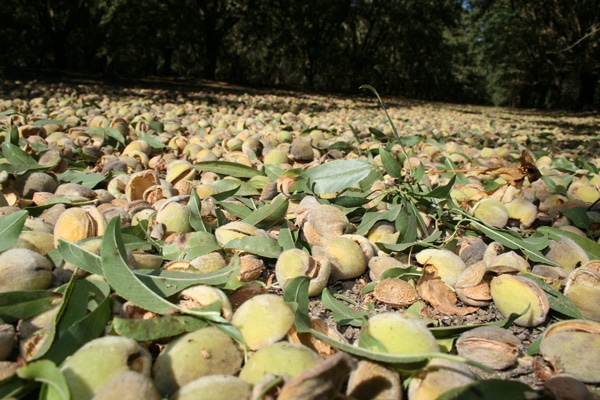August 19, 2015

California almonds get good marks when it comes to their carbon footprint compared to other protein foods.
That was among the findings of University of California researchers who did what they are calling a “cradle to grave” look at the industry, a life-cycle assessment of how the industry fares on greenhouse gas emissions and energy use with trees usually in the ground for 25 years.
UC Davis and UC Agriculture and Natural Resources scientists found that almonds have a relatively small carbon footprint, and that it could be further reduced with some changes in management practices.
It’s clear that byproducts ranging from hulls used to feed dairy cows to shells used for livestock bedding figure significantly into the findings of researchers.
Those researchers included Alissa Kendall, an associate professor in the UC Davis Department of Civil and Environmental Engineering; Sonja Brodt, academic coordinator in the UC ANR Sustainable Agriculture Research and Education Program; Elias Marvinney, a graduate student in the UC Davis Department of Plant Sciences; and Weiyuan Zhu, a UC Davis graduate student in horticulture and agronomy.
“Our research shows that 1 kilogram of California almonds typically produces less than 1 kilogram of carbon dioxide emissions, which is a lower carbon footprint than many other nutrient- and energy-dense foods,” Kendall said.
The researchers’ findings appear in the Journal of Industrial Ecology. The research was supported by grants from the Almond Board of California and the California Department of Agriculture Specialty Crop Block Grant Program.
Kendall said the industry’s carbon footprint could become “carbon neutral or even carbon negative largely through the improved utilization of orchard biomass.”
“We know when orchards are removed 98 percent of that biomass goes to power plants for renewable electricity,” she said. “Efficiency could be improved, but power plants are old technology.”
And factors that govern their use – including location and policy decisions – are “out of the control of growers,” Kendall said.
She pointed to other variables in efficiency, including water delivery systems that are highly differentiated, depending on the regions where almonds are grown.
Brodt said that only a full life-cycle model like the one developed by researchers “will allow us to accurately assess whether incorporating the biomass into the soil or using it for power generation instead results in a lower net carbon footprint.”
The research has its roots in the 2006 California Global Warming Solution Act that calls for greenhouse gas reductions and a look at the impacts of various industries.
In a webinar posted by UC, Brodt talks of the impacts of climate change that include reduced precipitation, reduction in the snow pack, fewer chill hours, less fog and impacts on pests and pollinators.
On a global basis, agriculture accounts for 10 to 12 percent of global greenhouse gas emissions, she said, and that does not take into account fuel, fertilizer and other factors that bring the figure closer to 30 percent.
Brodt said perhaps orchards can be credited for storing carbon: “Can we get credit for planting small forests?”
Marvinney, another webinar presenter, said that a study researchers conducted on almonds, walnuts, peaches, plums and pistachios could help policy makers better gauge those impacts and could help industries and others focus their attention on shrinking that footprint.
He pointed, for example, to a graph that showed a significant impact in use of natural gas for drying prunes. “That’s an area that potentially could be addressed,” Marvinney said.
He also talked of the effects of the drought and what that can mean “as so many trees are being pulled out. If there is an economic incentive to keep trees in the ground, that would keep perennial crops in production. What’s the alternative?”
Marvinney said regulators would be wise to take into account the idea of perhaps lengthening the life span for orchards, which he referred to as “managed forests.”
He said Australia, Chile and Spain are among countries where there is not the sort of biomass energy infrastructure that exists in California, adding that measures are being taken in the state to keep biomass energy plants open.
“But with natural gas prices very low, there’s less of an economic incentive to remain in operation,” Marvinney said.
On the positive side, he pointed out, the growing region is in closer proximity to those plants that are in operation, reducing the overall footprint left by transporting materials to the plants.
David Doll, a UC farm advisor in Merced County, said that as farmers improve their nitrogen and water use efficiencies, they can further reduce the carbon footprint.
“This will happen as we continue to transition into a nitrogen-budgeting system, which will further reduce over-applications of nitrogen,” he said. “Furthermore, research conducted by Cooperative Extension has shown that the entire biomass of an orchard can be incorporated back into the soil, which increases the amount of total carbon sequestered.”
About the Author(s)
You May Also Like




